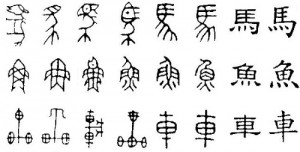Prompt: Each student will be assigned a section of the novel Green Grass Running Water (pages will be divided by the number of students). The task at hand is to first discover as many allusions as you can to historical references (people and events), literary references (characters and authors), mythical references (symbols and metaphors).
For this week’s assignment, I have been assigned pages 192-201 from GGRW, which in my text is actually pages 230-238. I will be referencing my own novel so hold on if things get a little confusing, I will try to use quotes where I can to help! To be honest, this particular collection of pages was difficult for me to tackle because it included snippets from each of the multiple storylines that weave throughout the novel. We find ourselves in the middle of the four old Indians discussing whose turn it is to tell the creation story to explain why there is so much water, with Robinson Crusoe beginning his version with the Thought Woman and the story of the River. Then we find ourselves in the middle of the storyline of the escaped elders on their way to Blossom to “change the world”, who have now found their way to the parking lot of the Blossom Lodge. Dr. Hovaugh and his assistant Babo have just arrived at the Canadian border in their quest to track down the escaped elders and bring them back to the mental institution. At first I wasn’t sure even where to start, but I realize the fact that I have the various intersections of plotlines allows me a lot of room in what to explore. With the help of Jane Flick and a little digging around of my own, I present to you some of the allusions I found:
Robinson Crusoe
The use of “Robinson Crusoe” as one of the names of the Old Indians is interesting for a variety of reasons. First and foremost, it alludes most obviously to the hero and main character from Daniel Defoe’s novel, “The Life and Adventures of Robinson Crusoe”, arguably one of the most popular and well-known travel narratives from the 18th century. Despite the novel’s success as a piece of literature that set a new standard for English novels of Defoe’s time, King makes criticisms on some of the more problematic themes like the novel’s legitimization of colonialism and its degrading and distorted depictions of the savage “Other” in the novel. In fact, the focus on the palm trees on Robinson Crusoe’s shirt early on in the novel on page 9 is an allusion to Daniel Defoe’s literary hero that “signals the desert island connection” and Crusoe’s subsequent christianizing and colonizing mission and interactions with his uneducated and uncivilized cannibal slave “Friday”.
Light
There is an emphasis on the turning on of lights in this segment of the novel, where Coyote the mischief trickster is constantly asking for attention as he “turn[s] on the light[s]” on page 230. This is a clear allusion to role of Coyote as the creator and the biblical reference Gen 1:3 when “God said, Let there be light.” Furthermore, light is a consistent symbol of heaven, enlightenment, hope, and religious guidance in Biblical literary stories and is constantly depicted in opposition to darkness. This light is also a reference to the “beginning”, and the creation of the world, a constant point of conflict between the Genesis story vs First Nation mythology in the search for the “true” creation story of how the world began.
“In the distance, at the edge of the horizon, Babo could see a point of light, a star in the morning sky…”
On page 235, Babo spots a star in the sky as her and Dr. Hovaugh make their way closer and closer to the Canadian border on their trip to find the escaped elders. This emphasis on following this star to their destination has clear allusions to the Biblical Star of Bethlehem that lead the 3 Wise Men to Jesus in the Nativity story. Similar to the biblical reference, Babo and Dr. Hovaugh are being guided by a star to find the four Elders that have escaped to Blossom, Alberta.
What did you think about these allusions? Did you see anything else that I failed to catch in my own analysis? Thanks for reading and have a great weekend!
Works Cited
Flick Jane. “Reading Notes for Thomas King’s Green Grass, Running Water.” Canadian Literature 161/162 (1999). Web. 4 Apr. 2013.
King, Thomas. Green Grass, Running Water. Toronto: Perennial Canada, 1993. Print.Saeed, Nourin. “Colonial Representation in Robinson Crusoe, Heart of Darkness and A Passage to India.” Thesis. BRAC University, 2013.
Swendenborg, E. “Spiritual Meaning of Light.” Bible Meanings. Web. 9 July 2015. <http://www.biblemeanings.info/Words/Natural/Light.htm>.
Wilson, Ralph F. “The Wise Men (Magi) and the Christmas Star of Bethlehem (Matthew 2:1-12) — Christmas Incarnation.” Web. 9 July 2015. <//www.jesuswalk.com/christmas-incarnation/magi-star.htm>.




